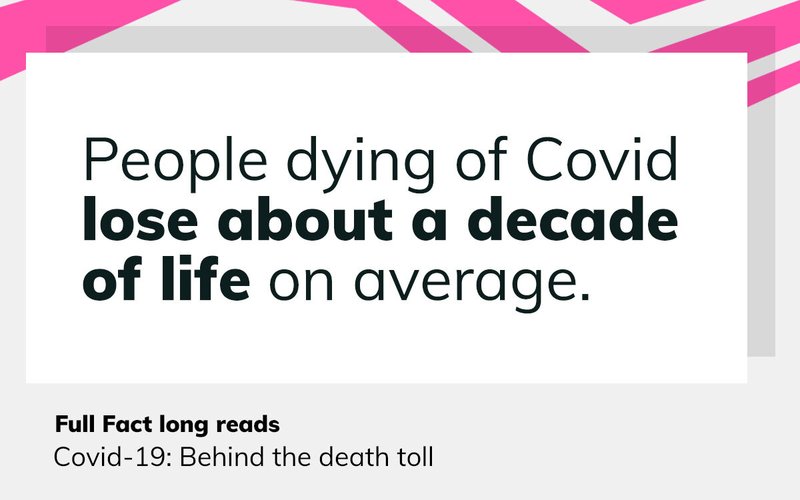Covid-19: Behind the death toll
We see the scale of this pandemic in another way if we look at the death toll alongside how many years of life are being lost—including among people who don’t die.

Readers have been asking us different versions of the same question for many months. Is it really true that just 697 people under 60, and without pre-existing health conditions, have died so far of Covid-19?
At the time of writing, yes, this is true. (With a few small caveats. These are only the people who died in English hospitals after a positive Covid test.)
Others have asked about people without pre-existing health conditions who are under 40. In this group the total number of Covid deaths is 89.
Some public figures, including the LBC radio presenter Maajid Nawaz and the journalist and broadcaster Julia Hartley Brewer have often mentioned these statistics in support of their wider opposition to lockdowns. Nigel Farage, the former leader of Reform UK, has said that the age of people dying means “we must put Covid-related deaths into perspective”. Their argument seems to be that most people could have carried on in spite of Covid, without the need for a national lockdown, as the virus affects the oldest and the illest most severely.
However, we need to be clear that the Covid deaths we’ve seen so far have been despite the UK’s lockdowns. As we have said before, the evidence suggests that without lockdowns the death toll would have been higher.

And while it is true that the pandemic has disproportionately affected older people, unlike previous large crises, such as the Second World War or the Spanish Flu, people dying of Covid have still lost about a decade of life, on average.
The figures raised by our readers also focus on deaths due to Covid, but the pandemic is doing great harm to people who do not die as well, affecting health and quality of life across the country in many ways that cannot be captured in the death toll alone.
Join 72,547 people who trust us to check the facts
Subscribe to get weekly updates on politics, immigration, health and more.
The scale of the disaster
The last time deaths rose so sharply was during the Second World War. The Office for National Statistics (ONS) has found that there were more excess deaths in 2020 in England and Wales (meaning more people dying than the recent average) than in any year since 1940.
Overall, data from the Commonwealth War Graves Commission (CWGC) shows that 666,747 people from or in the UK died in the war, 597,515 in the armed forces and 69,232 of them civilians. That last number includes every civilian who died in the Blitz, in an internment camp, in a shipping disaster or otherwise as a result of enemy action up to 1947.
In comparison, at least 149,117 people in the UK have died with Covid mentioned on their death certificate up to 12 March.
As a share of population (which was about 48 million in 1940, compared with about 67 million now) Covid has been mentioned as a cause in the deaths of 0.22% of the population. This is somewhat similar to the 0.14% of the population who were killed as civilians during the Second World War.
These are two immense disasters, quite different from each other, but the war allows us to compare the pandemic to a crisis of a similar scale.
The ages of those who died are different too. Using CWGC data, we can see that the average age of a UK civilian who died as a result of enemy action was about 40, while the average age of people dying from Covid is double that, at about 80.
While civilian deaths in the Second World War were fairly evenly distributed by age, this graph shows us that older people are much more vulnerable to Covid.
We can also look at each disaster in terms of the years of life that have potentially been lost. To do this, we need to estimate how many more years a person could expect to live, on average, at any given age—and therefore how many years they would lose by dying.
For instance, a 90-year-old in the UK today can expect to live, on average, another 4.5 years, according to the latest data from the ONS. Whereas an average 19-year-old can expect to live 62.9 more years. Precise data for life expectancy in wartime is harder to find, but we can make a rough estimate, based on the average expected age of death for a 40-year-old in 1940, which was about 72.
On this calculation, Covid deaths have taken away about 1.5 million years of potential life in the UK so far, whereas the war took away 2.1 million years of life from the civilians it killed.
However, the loss of life years from Covid is still enormous. Our calculation suggests that, on average, the people dying at these ages had about 10.5 years left to live. A recent study of Covid around the world estimated an average loss, per death, of 16 years. These figures do not take account of these people’s state of health, but other research that did produced a similar estimate, of about 10.5 years.
This comparison has many shortcomings. These charts do not adjust for the changing size of the UK population or the time span of these crises, or reflect armed forces deaths in the war, which were much higher.
Nor do they consider the wider effects of each disaster—the economic damage, the lasting mental and physical health problems, the weakening of the healthcare system’s ability to treat people for other things. These too will shorten or harm people’s lives in other, less direct ways. We can attempt to measure some of these costs, and the broader magnitude of the pandemic, using the quality-adjusted life year, or QALY.
Introducing the QALY
In the words of the National Institute for Health and Care Excellence (NICE), one QALY is equal to “1 year of life in perfect health”. This is then adjusted to take account of any reductions in someone’s quality of life, according to patients’ answers on questionnaires.
So for example, a year in poor health might be calculated at, say, 0.5 QALYs. Four years in that kind of health would therefore be the equivalent of two QALYs, six years at “half-health” would be three QALYs, and so on.

QALYs measure the years of life that may be lost when someone dies (mortality), as well as the quality of life that may be lost through other kinds of harm while people are still alive (morbidity). This means they can attempt to measure how much combined quantity and quality of life is being lost in a crisis—and perhaps how much we can save, according to our choices.
Three government departments and the ONS have been using QALYs in a series of research papers that attempt to measure the impact of Covid on England in various scenarios. The latest has not yet been peer reviewed, but was discussed by the Scientific Advisory Group for Emergencies (SAGE) in December.
QALYs do not tell us how we should value individual lives. Reducing someone’s lived experience, or indeed their death, to a single, comparable figure is unlikely to be possible. So QALYs certainly do not tell us that an ill or disabled person’s death is less important because their remaining life had lower “quality”. Indeed, without mentioning QALYs specifically, a group of disability campaigners warned about the dangers of this kind of thinking in a public statement in April 2020.
Some QALY measurements can also seem grotesquely reductive. The latest Covid impact paper, for instance, cites recent research that estimated the “health impacts of domestic abuse (including physical and emotional harms)” at 0.35 QALYs per person. In short, using measurements of the severity, frequency and duration of different types of harm that are associated with abuse it assumes that being abused takes away, on average, about a third of someone’s quality of life. Some might not argue with the accuracy of that figure, so much as whether it is even possible to estimate the cost of something so traumatic with a mathematical calculation.
Yet if the harms of domestic abuse are not estimated somehow, along with other forms of profound suffering, they run the risk of being ignored when policy decisions are being made.
In the words of the Green Book, which advises civil servants on how to appraise policies, programmes and projects, QALYs are one of several measures that should be used “when analysing and planning the provision of assets, goods and services at a population or sub-population level.”
How are QALYs used in practice?
The NHS has been using QALYs to make spending decisions for a long time. Broadly speaking, NICE only recommends treatments that cost less than £30,000 for each QALY that they add to someone’s life, although it does consider other factors too, and had planned to review its approach.
Right now, people are being given vaccines mostly in order of age, because the Joint Committee on Vaccination and Immunisation calculated that this is the best way of saving both QALYs and lives.
“We ourselves want to increase engagement with QALYs as a measure, because it is more informative than considering deaths alone,” says Greg Ceely, who is Head of Health Index and Projections at the ONS, and who worked on the Covid impact paper.
How many QALYs has the pandemic cost?
The estimates in the government’s impact document are very uncertain. They present potential scenarios, not predictions about what will happen. They do not consider every factor, nor do they take account of any new variants of the Covid virus. But they do provide another way to think about what’s at stake.
The document considers a scenario in which things went roughly as they did between March and September last year, after which there would be a large winter spike, and a lockdown, altogether causing about 70,000 excess deaths between October 2020 and the end of February 2021. (50,536 excess deaths were eventually recorded in England between 26 September 2020 and 26 February 2021.)
Overall, the document finds that this scenario would lead to a loss of about 4.4 million QALYs in England from a wide variety of causes—both Covid itself (1.1 million) and from other things (3.3 million).
Some of those QALYs would be lost as a result of people dying. Many others would be lost to other forms of suffering among people who did not die. For example, the document estimates a loss in this scenario of 174,000 QALYs from “long Covid”, when symptoms persist for a long time. A few QALYs would even be gained, for instance from the reduction in air pollution and road accidents.
Altogether, 4.4 million QALYs is roughly the “equivalent” of 100,000 people dying, if they each lost an average of 44 years of life in perfect health.
One revealing aspect of the document is how much harm we might experience beyond the daily death numbers. As you can see, in this scenario, Covid does most harm directly through the deaths it causes. The pandemic more generally, including our efforts to control Covid, also does enormous damage, but this is mainly through the loss of people’s quality of life.
This does not mean that lockdowns do more harm than good. The same researchers found in a “counterfactual” analysis that if the spread of Covid infections is not controlled, it has the potential to cause vastly more harm, at least in the short term.
The research also looked in detail at a list of 20 “wider health impacts”—from “alcohol use” to “home accidents”. With the evidence available, it then estimated how many quality-adjusted years of life would be lost or gained as a result of each.
Not all of the effects they found were obvious. For instance, the estimated harm from alcohol use in this scenario is large, at a loss of 27,800 QALYs. Yet the estimated harm from musculoskeletal disorders, assumed to rise by 25% as people are forced to work from home without good office furniture, is more than ten times as great, at 352,100 lost QALYs.
It isn’t easy to feel what a lost QALY or a life year means. Not like we feel the loss of somebody we care about. Nor do they tell us everything about the pandemic.
Instead, these measures help us to see things from a different angle. The full effects of a death or life-changing illness cannot be truly captured by a number. But QALYs are important, because they add to our understanding of how serious the situation is, and what we need to do about it.